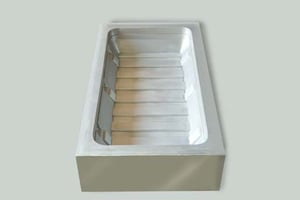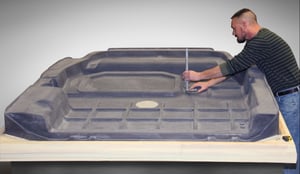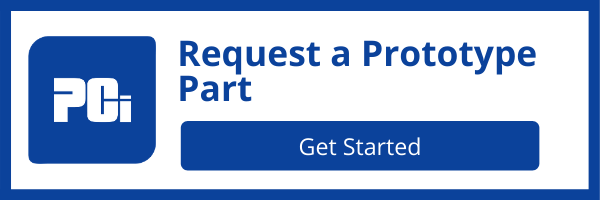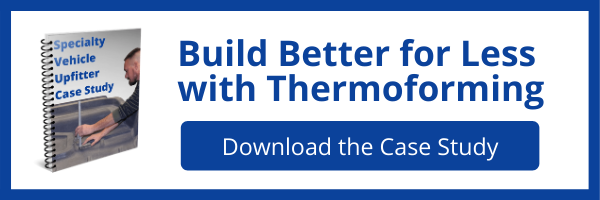Replacing Metal Parts with Thermoformed Plastic Parts
The discussion and debate has been going on since the beginning of modern plastics fabrication—metal versus plastic?
It’s a discussion many end-users and plastic part manufacturers still have with suppliers and customers. However, today, there is a greater level of knowledge and technical sophistication brought to it.
 Better Materials
Better Materials
Advances in materials and processes and changes in customer and industry needs have closed many of the physical property, application, and performance gaps between metal and plastic.
Today, with rising commodity prices and supply chain challenges, it is imperative for companies to investigate new ways to remove costs and add value for their customers.
With PCI’s years of experience as a guide, it is easier than ever to capitalize on the inherent advantages of thermoforming and convert your metal parts to plastic quickly.
For an increasing number of applications, plastic thermoformed parts can effectively compete with metal parts made from various forming processes, including manual sheet metal fabrication, metal stamping, and die pressing.
The most common sheet metal material is steel, although aluminum, tin, and other materials are also used. Most sheet metal raw material is supplied in a sheet thickness or gauge between 0.006 in. and 0.250 in.
Sheet metal forming is a relatively low-cost process for parts with simple designs such as single-directional bends. As part complexity increases, however, the fabrication process requires additional steps, such as cutting, bending, and stretching, to meet the design specifications.
Better Designs
Some designs may require multi-part assembly accomplished by welding, bonding, riveting, fastening, or a crimped seam. As multiple steps accumulate in metal fabrication, thermoplastic thermoforming becomes an effective alternative, enabling a reduction in parts, labor, cycle time, and costs.
Compared to stamped metal parts, thermoforming also offers the advantage of significantly shorter lead times to production and lower tooling costs. A thermoforming tool used in vacuum or pressure-forming processes comprises a single male tool.
Depending on the application, required tolerances, and expected production run, the tool can be made from steel, aluminum, or various polymer-based tooling materials, usually in six weeks or less. Cost savings for a thermoforming tool compared to a metal two-cavity press or die tool can exceed 50 percent.
Better Process
The most common type of thermoplastics forming process used in metal replacement applications is referred to as “heavy gauge” forming, a process with which PCI has years of expertise in designing and manufacturing parts for clients in automotive, electronics, and other industries. Heavy gauge forming refers to a broad class of thermoplastic sheets ranging in thickness from 0.060 in. to 0.50 in.
 PCI can use both vacuum-forming and pressure-forming processes for metal-to-thermoplastic part conversion. In vacuum forming, a thermoplastic sheet is secured over the mold.
PCI can use both vacuum-forming and pressure-forming processes for metal-to-thermoplastic part conversion. In vacuum forming, a thermoplastic sheet is secured over the mold.
The sheet is heated to its forming temperature, and the air is evacuated from the mold, pulling it onto the mold surface. The mold is cooled, the formed part is removed from it, and the part is CNC-trimmed to the part specifications.
The plastic sheet is secured above the mold and heated to its forming temperature in the pressure-forming process. Air pressure is applied above the mold and vented below, pushing the “A” surface or visible side of the plastic sheet against the mold surface. The applied pressure provides tighter radii, similar to an injection-molded part.
The pressure also delivers a consistent surface finish from part to part while allowing the flexibility to introduce paint film, surface texturing, and other decorative elements. For this reason, pressure forming is usually the choice for parts and components with surface aesthetic requirements.
PCI can assist customers by converting a metal part to a thermoplastic process that will meet their engineering and performance specifications for their specific part.
For clients looking to capitalize on the benefits of metal-to-plastic conversion, PCI can guide them through the best options for design, tooling and fixture configurations, material selection, and decorative and aesthetic features in a single turnkey process.
Strength and Stiffness
When addressing strength/stiffness, it’s important to remember that almost every part is designed to meet a minimum specific strength-to-weight or stiffness-to-weight ratio. Accordingly, these specified values vary across a wide range of applications.
Because plastics are lighter than metal, as measured by a material’s specific gravity or density, thermoformed thermoplastic parts can often compete with metal in certain applications by providing similar performance levels.
The inherent design flexibility of plastic thermoforming allows PCI engineers to design parts with increased wall thickness in critical structural areas requiring higher strength and stiffness. Strength and stiffness can be enhanced further by adding glass or carbon fiber to create specialized, reinforced thermoplastic matrices.
As a rule, commonly used plastics such as polypropylene, ABS, and polycarbonate (PC) are approximately two times lighter than aluminum and up to three times lighter than stainless steel. Twenty percent glass-filled acetal is about 50% heavier than ABS and PC, but still nearly two times lighter than steel.
The so-called practice of “light-weighting” is a long-established trend in the automotive, aerospace, and other industries. It allows OEMs to capture all of the cost benefits of thermoforming and helps them meet increasingly stringent regulations for fuel efficiency and emissions. For example, reducing 800 lb. on a municipal transportation bus results in a fuel savings of 2 to 3%.
Converting to thermoplastic thermoforming
 At first glance, converting from one manufacturing process to another may appear complex and challenging. However, with PCI’s experience and support, it need not drain the customer’s time and resources.
At first glance, converting from one manufacturing process to another may appear complex and challenging. However, with PCI’s experience and support, it need not drain the customer’s time and resources.
While it will likely entail more than simply handing over your existing part design and tooling, PCI’s in-house engineering staff will guide customers through the process to provide a fast, cost-effective conversion.
The first critical steps in the process will be material selection and part design. As the process and materials used for forming metal are fundamentally different from those comprising thermoforming, these differences will more than likely necessitate modifications to your existing part design and tooling.
There are multiple types of thermoplastics, each with its own specific properties, advantages, and disadvantages. When converting metal to plastic, it is crucial to select the right material for the application. PCI will collaborate with the customer to help select the ideal material.
Once the material is chosen, PCI will initiate part design to meet all product and performance specifications while keeping the customer informed throughout the process. Various options or “trade-offs” often present during design, with the customer having the final say on any design decisions.
Once the part design is decided, it is usually recommended that a prototype part be built for testing to evaluate dimensional, structural, material, and any other properties to specified standards. Customer collaboration is key in creating a successful part validation plan, as 70 to 90 percent of product cost is determined by part design.
The final step in conversion is production-grade tool design and build, which, in some respects, mirrors the part design process in terms of selecting tooling material and any auxiliary equipment needed to manufacture the part on a production basis. The expected number of parts to be made in the production run will strongly influence the tooling material and equipment choice.
PCI’s years of plastic thermoforming experience allow us to readily adapt and convert customers’ existing metal part designs to capture all the advantages of thermoforming manufacturing while minimizing the time, cost, and concerns involved.
Contact us if we can help you convert your metal parts to thermoformed plastic parts!
